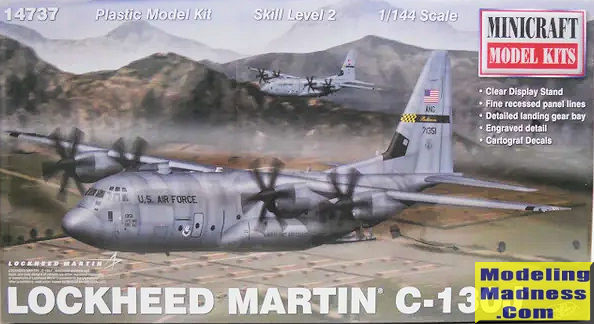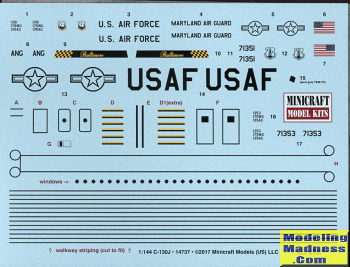
Minicraft 1/144 C-130J Hercules
| KIT #: | 14737 |
| PRICE: | $36.53 delivered |
| DECALS: | Two options (different serials) |
| REVIEWER: | Scott Van Aken |
| NOTES: | 2017 release |

| HISTORY |
The Lockheed Martin C-130J Super Hercules is a four-engine turboprop military transport aircraft. The C-130J is a comprehensive update of the Lockheed C-130 Hercules, with new engines, flight deck, and other systems. The Hercules family has the longest continuous production run of any military aircraft in history. During more than 60 years of service, the family has participated in military, civilian, and humanitarian aid operations. The Hercules has outlived several planned successor designs, most notably the Advanced Medium STOL Transport contestants. As of February 2018, 400 C-130J aircraft have been delivered to 17 nations.
The Super Hercules has been used extensively by the USAF and USMC in Iraq and Afghanistan. Canada has also deployed its CC-130J aircraft to Afghanistan. C-130Js from several countries have been deployed in support of the US Operation Odyssey Dawn and NATO's Operation Unified Protector during the 2011 Libyan civil war. From the first flight on 5 April 1996 to 30 April 2013, 290 C-130J Super Hercules aircraft operated by 13 nations surpassed 1 million flight hours. Apparently the aircraft is still in production with the USAF hoping to replace all of it earlier variants (now pretty much limited to the C-130H).
In January 2013, it was reported that some of Canada's CC-130J transports had counterfeit Chinese microchips in their cockpit displays. These parts are more likely to fail and result in failures such as blank instrument screens during flight. A 14-month investigation by the U.S. Senate Armed Services Committee concluded that counterfeit parts in the Hercules and other American-made military equipment are prone to failure with potentially "catastrophic consequences." The U.S. congressional investigation reported the fake Hercules microchips were originally made by the Korean electronics giant Samsung in the 1990s, and more than a decade later, had been recycled, refurbished and remarked to appear genuine by a company in China. Samsung later stated that "it is not possible to project the reliability" of the altered parts. The U.S. investigation reported that the problems on the Hercules first came to light in 2010 when the instrument panel failed on a USAF aircraft during active duty.
On 20 August 2013, the Indian Air Force performed the highest landing of a C-130J at the Daulat Beg Oldi airstrip in Ladakh at the height of 16,614 ft (5,064 m).
| THE KIT |
 Minicraft
has produced kits of most of the Hercules variants so far so it was
not surprising that it would do a J model as well. Also not
surprising is that it uses extant tooling for the earlier versions
along with additional sprues to take care of the differences.
Minicraft
has produced kits of most of the Hercules variants so far so it was
not surprising that it would do a J model as well. Also not
surprising is that it uses extant tooling for the earlier versions
along with additional sprues to take care of the differences.
 Instructions
are well drawn and provide minimal color info during the build. I'm
not sure if the gear wells and struts are actually aluminum as I'm
used to seeing these sorts of things painted white. Check the net.
There are two options that differ only by serial number. Both are in
overall AMC grey and are with the Maryland ANG. The black areas for
the exhaust and the fin base will also need to be painted in place.
The decal sheet is nicely done and provides the black stripes for
the upper fuselage/wing walk areas. As usual, all the doors and
windows save the cockpit ones are decals.
Instructions
are well drawn and provide minimal color info during the build. I'm
not sure if the gear wells and struts are actually aluminum as I'm
used to seeing these sorts of things painted white. Check the net.
There are two options that differ only by serial number. Both are in
overall AMC grey and are with the Maryland ANG. The black areas for
the exhaust and the fin base will also need to be painted in place.
The decal sheet is nicely done and provides the black stripes for
the upper fuselage/wing walk areas. As usual, all the doors and
windows save the cockpit ones are decals.
| CONCLUSIONS |
| REFERENCES |
https://en.wikipedia.org/wiki/Lockheed_Martin_C-130J_Super_Hercules
April 2019
Copyright ModelingMadness.com. All rights reserved.
My thanks to me for picking this one up on sale.
If you would like your product reviewed fairly and fairly quickly, please contact the editor or see other details in the Note to Contributors.
Back to the Main Page Back to the Previews Index Page Back to the Review Index Page